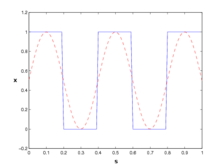Bang-bang approximation of a traveling wave
The following problem is an academic example of a PDE constrained optimal control problem with integer control constraints and was introduced in <bibref>Hante2009</bibref>.
The control task consists of choosing the boundary value of a transport equation from the extremal values of a traveling wave such that the -distance between the traveling wave and the resulting flow is minimized.
Mathematical formulation
where
is the traveling wave (oscillating between 0 and 1), is a (small) regularization parameter and denotes the variation of over the interval . Thereby, the solution of the transport equation has to be understood in the usual weak sense defined by the characteristic equations. Systems biology
Reference solution
For the best known solution is given by
where denotes the indicator function of the interval .
- Obtained solution plots
-
Solution obtained using a projected gradient method based on switching time sensitivities.
-
Corresponding plots of the differential states (blue) and the wave (red) at .
References
| [Hante2009] | Hante, Falk M.; Leugering, G\"unter (2009): Optimal Boundary Control of Convention-Reaction Transport Systems with Binary Control Functions. Springer-Verlag, HSCC '09: Proceedings of the 12th International Conference on Hybrid Systems: Computation and Control |  |

